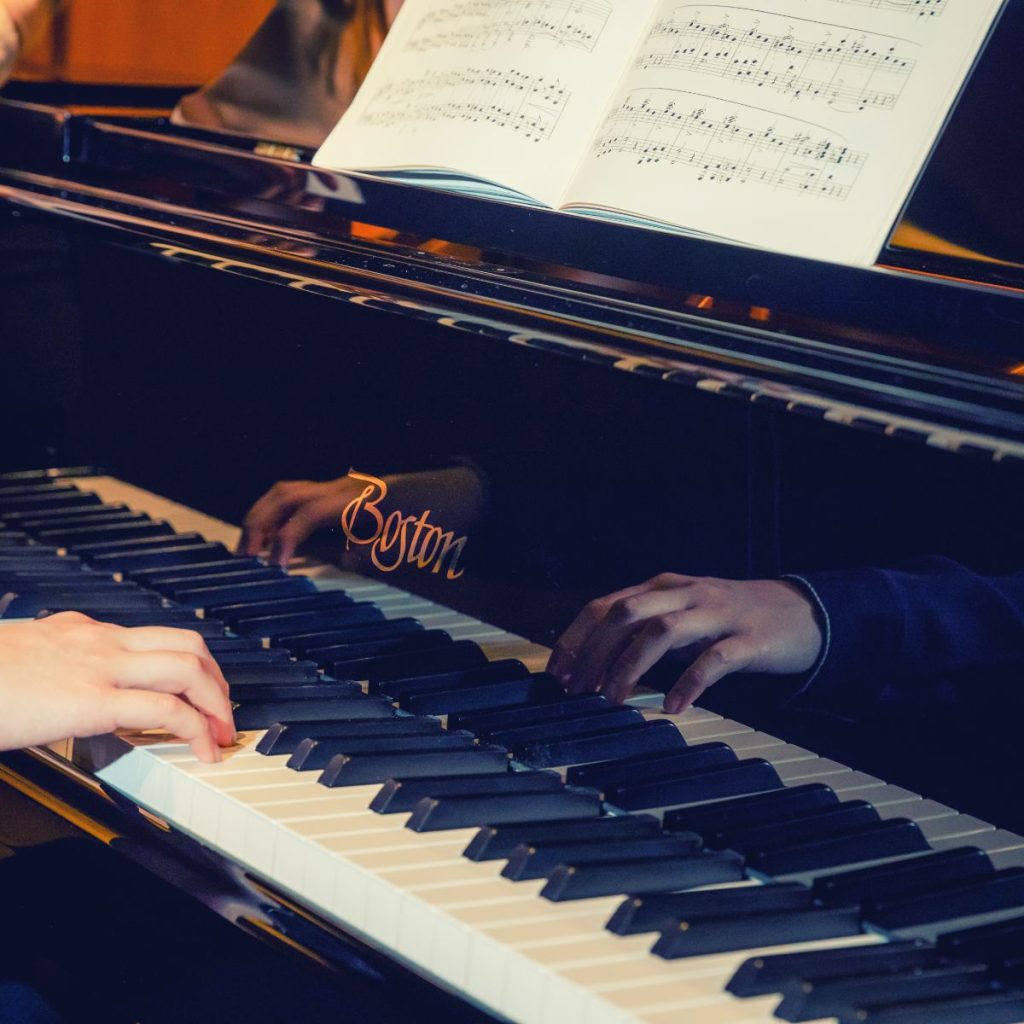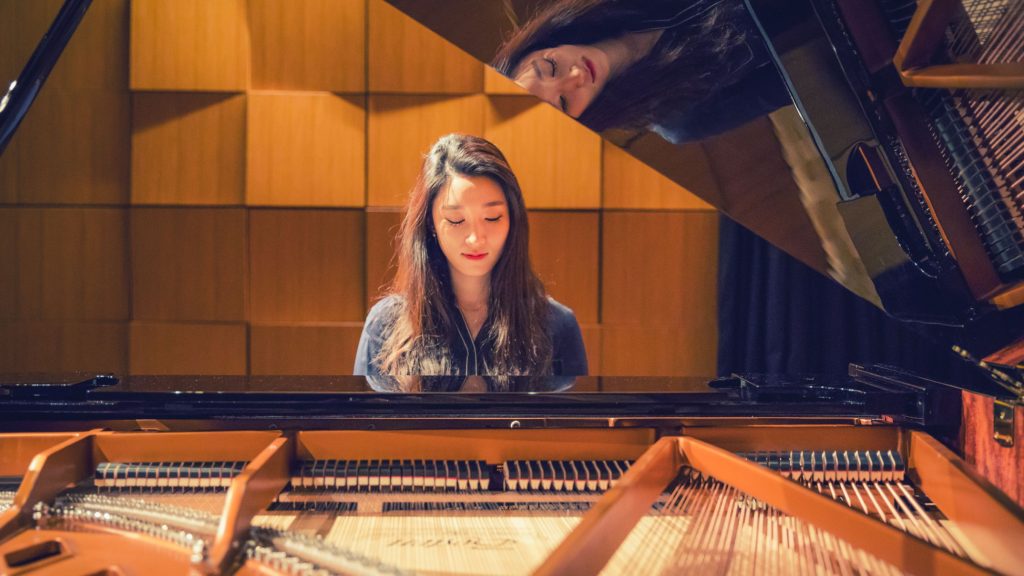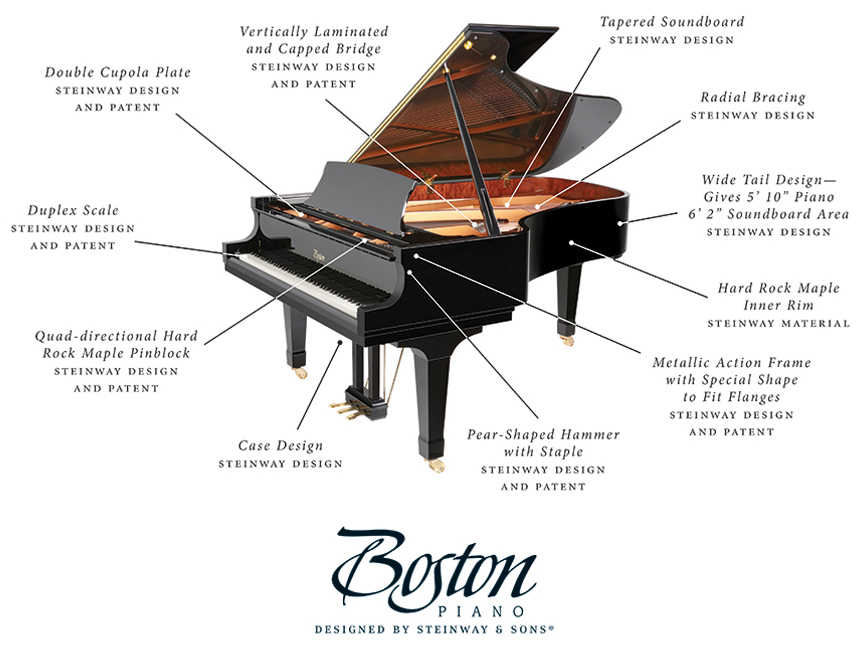The Steinway–Designed Boston
Simply a better piano.
When Henry E. Steinway and his sons founded what would become the world’s most famous piano company in 1853, they promised to passionately execute Henry’s ambitious vision: “To build the best piano possible.” This 169-year-old mission statement is today imbued in every element of the Steinway brand, including the Steinway-designed Boston piano.
The Boston, born in 1992, is the culmination of Steinway & Sons’ decision to develop a new line of instruments to meet the needs of piano connoisseurs not yet ready for a Steinway. Designed by Steinway, the Boston is manufactured using a recipe developed from Steinway’s more than sixteen decades of premier piano-building and commitment to continued improvement.
Through its adherence to Steinway design principles, the Boston maintains its position as the best piano available in the popularly priced market, bar none. Thanks to its Steinway pedigree, the Boston sounds better, plays better, and lasts longer than any other piano in its price range.
SOUNDS BETTER.
There are distinct design differences between the Boston and any other piano in its market, and these design distinctions are born of the Steinway recipe. Just as the Steinway is known for its unmistakable “Steinway Sound,” so, too, has the Boston developed a reputation for a distinctly pure, rich sound that simply can’t be reproduced by other pianos.
The Boston owes its superior sound to Steinway–designed advancements:
- Steinway & Sons Engineers designed the Boston from the ground up at Steinway & Sons’ New York factory, calling upon 169 years of pioneering piano manufacturing.
- Steinway–designed low-tension scaling results in a longer sustaining tone and longer life of the whole piano. A low-tension string scale design gives a fuller tone by allowing more of the lower partials to sing. It also has more sustain, is more powerful, has more dynamic range, and provides warmer and mellower tones.
- The linearly tapered solid Sitka–spruce soundboard, designed for optimal vibrational response, which provides a bigger, richer, fuller tone and increased sustain.
- The hard rock maple inner rim, which — by virtue of its superior qualities—produces less vibration and less absorption of sound to generate a better, fuller sound from the soundboard.
- The “wide-tail” design, which offers substantially more surface area on the soundboard to create a richer sound and the impression of playing on a larger instrument. Additionally, the wide-tail design permits longer bass strings, as they can be placed closer to the center of the soundboard, providing a much richer, deeper and colorful bass.
- Pear-shaped hammers manufactured on a Steinway-owned hammer press. Striking the strings at exactly the right spot, these hammers are designed to produce the best tonal result.
- Solid copper-wound bass strings — made by Mapes Piano String Company in Tennessee, USA — will last longer than copper-plated on steel. It also ensures pure tone for the life of the instrument. Steinway–patented overstringing permits maximum speaking length of bass strings and a smoother transition from bass to tenor.
- The Steinway-patented, vertically-laminated maple bridge with solid maple cap, which provides the best transfer of energy from bridge to soundboard. The patented bridge is also placed closer to the center of the soundboard in Boston grands, thus allowing for a more even disbursement of energy and resulting in a richer, fuller tone.

The low-tension string scale design gives a fuller tone, more sustain, and more dynamic range.

The “wide-tail” design offers more surface area on the soundboard to create a richer sound.

The hard rock maple inner rim reduces vibration to generate a better, fuller sound from the soundboard.

The Boston design emphasizes sophisticated geometry and the highest-quality construction materials.

Solid copper-wound bass strings ensure pure tone for the life of the instrument.

The solid Sitka–spruce soundboard is linearly tapered to produce a richer, fuller tone.
PLAYS BETTER.
From students to teachers to performing artists, pianists who play Boston know the benefits of the Boston “feel” and are passionate about its superiority to the touch of other pianos in its price range. The trademark responsive action of the Boston is owed to its Steinway pedigree, which emphasizes sophisticated geometry and the highest-quality construction materials.
Like Steinway, Boston uses all-wood action parts — never plastic like many competitors. Wood helps to determine the Boston’s characteristic feel and allows the player to experience the “feedback” from the keyboard that is found only in performance-level instruments. In addition, Boston pianos feature Steinway–patented (and famous) rosette-shaped flanges, which mate positively with the action rail, lock into place, and prevent any twisting or shifting of the action parts. This means that despite humidity, temperature changes, or heavy use, the Boston’s action is forever tight, sharp, and responsive.
The rosette shape on Boston’s action rail was originally patented by Steinway in 1868: it’s a time-tested hero when it comes to piano “feel” and stability, and no other similarly-priced piano offers it. In addition, the design of the Boston action requires less energy to start the hammer moving, permitting pristine repetition, an extremely responsive action, and greater control over a tremendous dynamic range.


LASTS LONGER.
Like the Steinway from whence it came, the Boston piano is designed for legacy and longevity. With its unique, proprietary design, Boston has emerged since 1992 as an affordable workhorse with an elegant pedigree and long-lasting heirloom potential. While the overwhelming foundation of the Boston’s durability stems from its adherence to Steinway design and Steinway–sanctioned manufacturing and materials, there are specific points that offer it a long-lasting playing life:
- Radial bracing (on Boston grands) ties the framework of the instrument together and supports the rim; and staggered backposts (on Boston uprights) address tension where it is greatest and ensure stable tunings and an overall longer life.
- The low-tension string scale works seamlessly with these two unique Boston bracing systems. Physics guarantees that this design creates a piano with less stress that is better able to handle tension and prolonged use.
- Inspired by the revered Steinway Hexagrip® pinblock, the Boston’s Steinway-patented Octagrip® pinblock is constructed from eleven layers of hard rock maple. These layers are glued in different grain angles to keep the tuning pins tight but allow for fluid motion. The result is improved tunings, greater tuning stability, and overall extended piano life.
The Steinway-designed benefits of Boston pianos are real. Boston is designed by the world’s most revered piano maker, utilizing expertise and technologies honed over 169 years. Built in manufacturing facilities with the ability to build exactly according to the Steinway design, the Boston is fashioned from a famously-exacting recpe for piano greatness — one which has found countless passionate devotees the world over. And based on the ever-increasing number of Boston pianos sold to music schools and institutions, where performance and longevity are paramount, it’s clear that the word is out on Boston.

